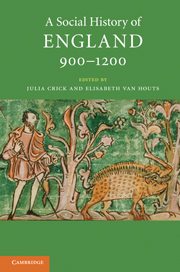Book contents
- Frontmatter
- Contents
- List of figures
- List of maps and tables
- List of contributors
- Acknowledgements
- List of abbreviations
- Map 1 England and its neighbours
- Map 2 England 900–1200
- I Introduction
- I.1 Land use and people
- I.2 Water and land
- I.3 Forest and upland
- I.4 Mineral resources
- I.5 Health and disease
- II.1 Authority and community
- II.2 Lordship and labour
- II.3 Order and justice
- II.4 War and violence
- II.5 Family, marriage, kinship
- II.6 Poor and powerless
- III.1 Towns and their hinterlands
- III.2 Commerce and markets
- III.3 Urban planning
- III.4 Urban populations and associations
- IV.1 Invasion and migration
- IV.2 Ethnicity and acculturation
- IV.3 Intermarriage
- IV.4 The Jews
- V.1 Religion and belief
- V.2 Rites of passage and pastoral care
- V.3 Saints and cults
- V.4 Public spectacle
- V.5 Textual communities (Latin)
- V.6 Textual communities (vernacular)
- VI.1 Learning and training
- VI.2 Information and its retrieval
- VI.3 Esoteric knowledge
- VI.4 Medical practice and theory
- VI.5 Subversion
- Glossary
- Time line 900–1200
- Further reading
- Index
- References
III.3 - Urban planning
Published online by Cambridge University Press: 05 June 2012
- Frontmatter
- Contents
- List of figures
- List of maps and tables
- List of contributors
- Acknowledgements
- List of abbreviations
- Map 1 England and its neighbours
- Map 2 England 900–1200
- I Introduction
- I.1 Land use and people
- I.2 Water and land
- I.3 Forest and upland
- I.4 Mineral resources
- I.5 Health and disease
- II.1 Authority and community
- II.2 Lordship and labour
- II.3 Order and justice
- II.4 War and violence
- II.5 Family, marriage, kinship
- II.6 Poor and powerless
- III.1 Towns and their hinterlands
- III.2 Commerce and markets
- III.3 Urban planning
- III.4 Urban populations and associations
- IV.1 Invasion and migration
- IV.2 Ethnicity and acculturation
- IV.3 Intermarriage
- IV.4 The Jews
- V.1 Religion and belief
- V.2 Rites of passage and pastoral care
- V.3 Saints and cults
- V.4 Public spectacle
- V.5 Textual communities (Latin)
- V.6 Textual communities (vernacular)
- VI.1 Learning and training
- VI.2 Information and its retrieval
- VI.3 Esoteric knowledge
- VI.4 Medical practice and theory
- VI.5 Subversion
- Glossary
- Time line 900–1200
- Further reading
- Index
- References
Summary
Proto-urban sites of various types had been a feature of Anglo-Saxon England, especially Mercia, for some time before the late ninth century, and from the 870s to 890s, under the influence of Viking attacks, Viking settlement and an energetic fortification programme in Wessex by Alfred the Great (king of Wessex 871–99), urbanization in England became more vigorous. The sites fortified in or by the late ninth and the tenth centuries were usually based at river-crossings and also on major roads. Permanent garrison settlements, coupled with the need for regulated markets to allow rulers to tap into profits from sales, encouraged many places to become urbanized. Defences were therefore an important feature of many urban places in England in the 900–1200 period, and certainly of the larger ones, including most of the shire towns; they often helped to determine the planning of streets and other minor features within the areas they demarcated. Also significant in deciding the internal layout of towns were major churches, especially, though not only, where these preceded urban development; in particular, Anglo-Saxon minster churches and Benedictine abbeys fostered the growth of markets and towns. Sites associated with secular political authority tended to be less influential than major churches, but nonetheless could influence internal organization, especially with the need to find sites for royal castles in major towns after the Norman Conquest.
- Type
- Chapter
- Information
- A Social History of England, 900–1200 , pp. 188 - 197Publisher: Cambridge University PressPrint publication year: 2011



